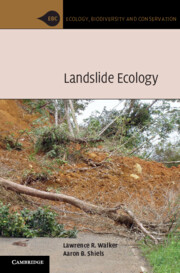7 - Large scales and future directions for landslide ecology
Published online by Cambridge University Press: 05 January 2013
Summary
Key points
Landslide ecology is an emerging discipline that provides insights into both scientific and management issues. Scientifically, it explores nutrient cycling and soil development, plant physiological adaptations, dispersal and colonization dynamics, novel mixes of native and non-native species, and successional trajectories in an often inhospitable environment. Landslide ecology also integrates biological aspects of landslides into efforts to manage slope hydrology, soil erosion, and the stabilization of slopes.
Human–landslide interactions are becoming more common as human populations expand into mountainous terrain and climate change increases landslide frequency.
A landscape-level approach to landslide rehabilitation integrates topography, broad-scale climatic conditions, landslide density, patch dynamics, propagule dispersal, and coarse-scale predictive models.
We expect future contributions to landslide ecology will come from more effective technological tools to mitigate erosion and predict landslide hazards, an increased understanding of how plant–animal–soil interactions determine colonization patterns and successional trajectories, and practical contributions from efforts to use biological methods to stabilize landslides. Finally, we hope that the emergence of landslide ecology as a discipline will also improve our cultural perspectives of landslides, including the promotion of more sustainable uses of slopes and avoidance of erosion-prone areas.
- Type
- Chapter
- Information
- Landslide Ecology , pp. 227 - 240Publisher: Cambridge University PressPrint publication year: 2012

